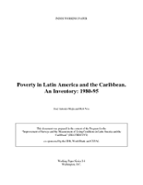Poverty in Latin America and the Caribbean: An Inventory: 1980-95
Date
Jan 1997
In this paper we will not intend to derive improved poverty measures for the Americas. Our pretensions are much more modest. The purposes of the paper are to provide an inventory of available poverty estimates for the countries of the region derived from a variety of studies and data sources (albeit mainly household surveys), to establish the degree of comparability of these estimates over time and across countries and to systematize the differences in conceptualization and methods of measurement explaining why poverty estimates may diverge so much. This should also help to put into perspective the poverty estimates for the region as included in the IDB's Economic and Social Data Base (ESDB) and other sources compiling such data. In this effort, we limit ourselves to the "income approach" to poverty, that is the definition and measurement of poverty in terms of a lack of resources required to purchase a minimum bundle of essential goods. As explained in Part 1 of this paper, this is only one possible approach to poverty measurement, albeit perhaps the most commonly used one and also the one central to the Bank's criteria to determine which of its operations qualify as "poverty targeted".



